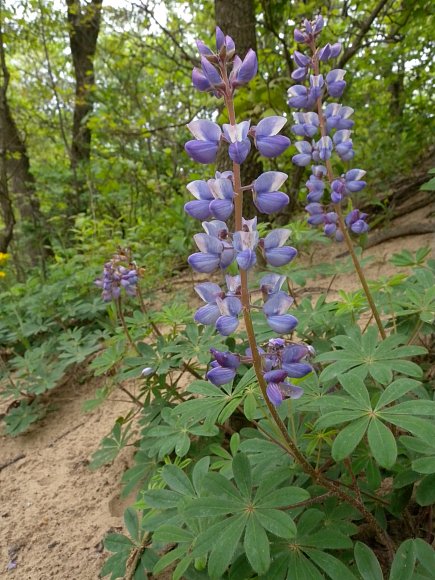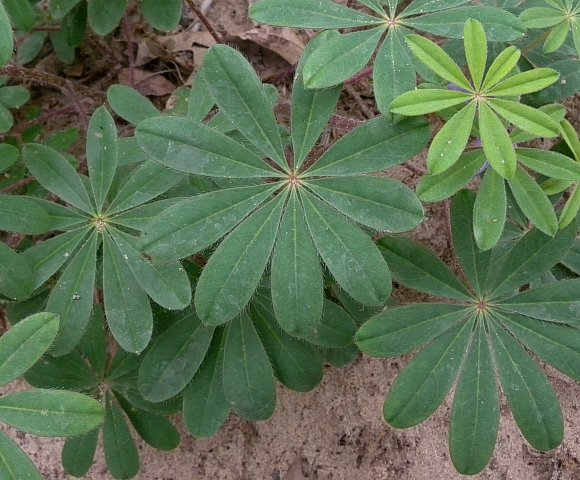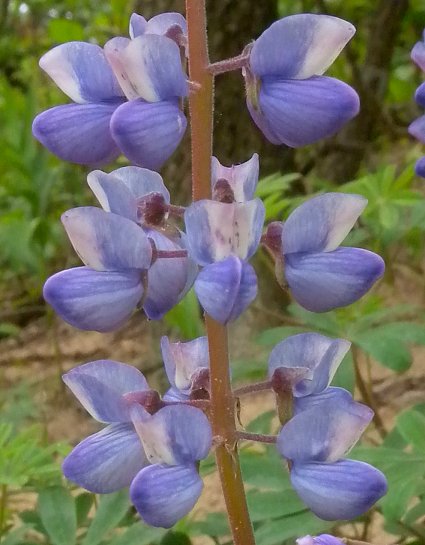Description: This perennial wildflower is 1-2½' tall and compactly branched. The stems are light green to reddish green, angular or terete, and canescent-hairy. Alternate compound leaves occur along the stems; individual leaves are palmate with 7-11 leaflets. Individual leaflets are 1-2½" long and oblanceolate in shape; their margins are smooth and ciliate. The upper surface of the leaflets is medium green and hairless, while the lower surface is pale green. Each compound leaf has a long ascending petiole about 1-4" long that is light green to reddish green. The stems, petioles, and leaf undersides are sparsely to moderately canescent-hairy. The upper stems terminate in narrow racemes of flowers about 4-10" long. The flowering stalks are light green to reddish purple. Individual flowers are about ¾" long, consisting of 5 blue-violet petals (rarely white or pink), a tubular calyx with large lobes, several stamens, and a pistil with a single style. The petals have a pea-like floral structure, consisting of a large upper banner and 2 wings that project forward to enclose the keel. The lateral edges of the banner fold backward from its center; as a flower ages, the center of the banner becomes more white. The calyx is light green to reddish purple. The slender pedicels of the flowers are up to ½" long. The flowering stalks, calyces, and pedicels are sparsely to moderately canescent-hairy. At the base of each flower, there is a linear-lanceolate floral bract that soon withers away.

The blooming
period occurs from late spring to early summer and lasts about 1 month
for a colony of plants. Afterwards, the flowers are replaced by
elongated seedpods about 1¼-2" long and canescent-hairy. Each seedpod
contains about 7 seeds, which can be ejected several feet away from the
mother plant. The root system consists of a taproot with rhizomes.
Reproduction is by seed and vegetative clones from the rhizomes.
Cultivation:
The preference is full or partial sun, mesic to dry conditions, and an
acidic soil containing sand or sandy loam. The root system can fix
nitrogen into the soil. The seeds should be scarified to facilitate
germination. Individual plants can be short-lived or long-lived,
depending on environmental conditions.
Range & Habitat:
Wild Lupine is an uncommon native wildflower that is found in NE
Illinois and other northern areas of the state (see Distribution
Map). Because of habitat destruction and fire suppression,
populations of this wildflower have declined. Habitats include sand
prairies, openings in sandy woodlands, sandy savannas, edges of sandy
woodlands, stabilized sand dunes, and powerline clearances in sandy
areas. Dominant canopy trees in some of these habitats are either oaks
(especially Black Oak) or pines.

Faunal Associations: The flowers are cross-pollinated primarily by honeybees, bumblebees, digger bees (Synhalonia spp.), Mason bees (Osmia spp.), and other long-tongued bees. Other floral visitors include Halictid bees and bee flies. Only pollen is available as a floral reward, which is forcibly ejected into the faces of such insect visitors. Occasionally, the Karner Blue and other butterflies visit the flowers, searching in vain for nectar. Several insects feed on the foliage and other parts of Wild Lupine. These insect feeders include caterpillars of the butterflies Lycaeides melissa samuelis (Karner Blue) and Callophrys irus (Frosted Elfin), and caterpillars of the skippers Erynnis baptisiae (Wild Indigo Duskywing) and Erynnis persius (Persius Duskywing). The caterpillars of several moths also feed on Wild Lupine: Caenurgina crassiuscula (Clover Looper), Grammia phyllira (Phyllira Tiger Moth), Grammia placentia (Placentia Tiger Moth), Utetheisa bella (Bella Moth), and Walshia miscecolorella (Sweet Clover Root Borer). Other insects feeders include Empoasca fabae (Potato Leafhopper), Hadronema militaris (Military Plant Bug), and seed-eating larvae of the weevil Apion minor. The foliage is toxic to sheep and horses, however deer, rabbits, and woodchucks occasionally browse on Wild Lupine.

Photographic
Location:
A wooded sand dune at the Indiana Dunes State Park in NW Indiana.
Comments:
This is the only lupine that is native to Illinois; species in this
genus are more abundant in the western United States. Wild Lupine is
readily distinguished from Baptisia spp. (Wild
Indigos) and other similar species in the Bean family by the abundant
leaflets of its palmate leaves (7-11 per leaf). Other similar species
in Illinois have either trifoliate leaves (3 leaflets per compound
leaf) or pinnate compound leaves. Both the flowers and foliage of Wild
Lupine are quite attractive. Another common name of this species is
Sundial Lupine, because the palmate leaves orient themselves in the
direction of the sun.